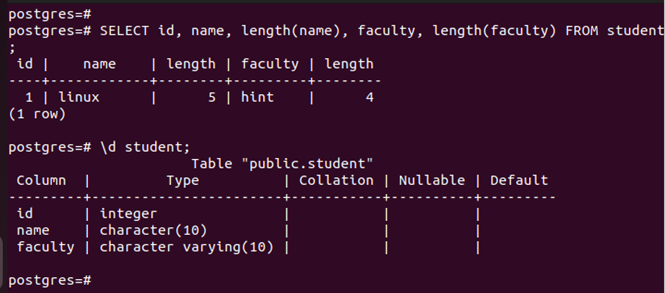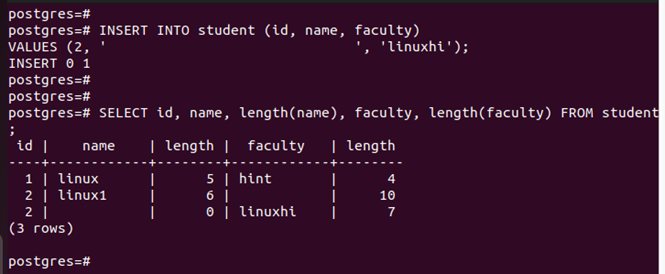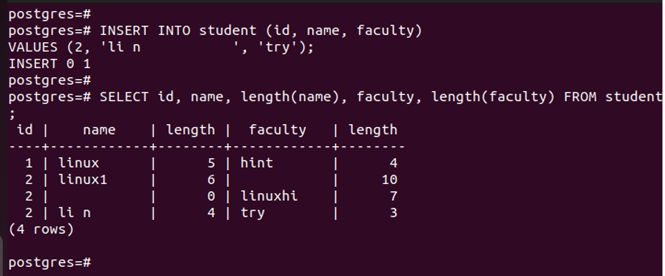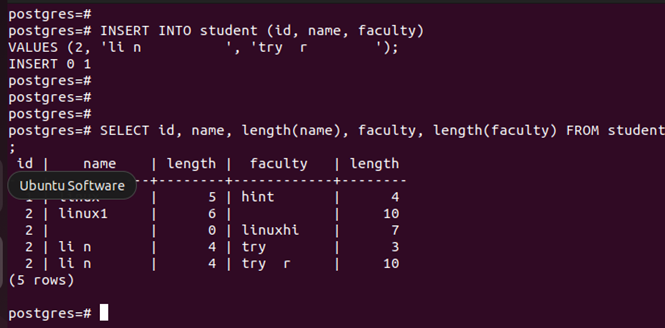PostgreSQL BPCHAR Data Type
Understanding CHAR(n) and VARCHAR(n) is essential in understanding the BPCHAR data type. This tutorial discusses everything about BPCHAR. We will understand how CHAR(n) and VARCHAR(n) work and where BPCHAR comes in. Let’s begin!
What Is BPCHAR in PostgreSQL
When working with any database, you must specify the data type of the columns that you create. That way, the database knows what type of values to expect for a given table. Hence, when you try to insert a value that doesn’t match the expected data type, the database raises an error.
In the case of PostgreSQL, BPCHAR is a data type that stands for “blank padded character.” It is associated with the CHAR data type and mainly comes into play when we try to add blank spaces as values. In such a case, the empty spaces are blank-padded to avoid raising any error.
To understand BPCHAR in detail, we create a table and see how CHAR and VARCHAR handle different values and where BPCHAR comes into play.
In our example, we create a simple table that takes CHAR(n) and VARCHAR(n) where “n” is 10. Here, “n” is the number of characters that can be accommodated.

If we inspect our table, we can confirm that all data types and columns are successfully created.

Now, let’s start by inserting values into our columns. The values, in this case, have a character length that are less than the specified character length of 10 for each data type.

We can verify the length of the inserted values using the length (column-name) option. In the following output, CHAR and VARCHAR have a value with fewer characters than the maximum specified length when creating the table.
You should note that the VARCHAR data type only uses the required length since it takes a variable length. However, CHAR takes up all the fixed length regardless of whether the inserted value requires fewer characters.

Suppose we try to insert a value that takes more characters than the length of the CHAR data type. We get the following error:

The same applies to VARCHAR. Although it has a variable length, it can’t accommodate any value that exceeds the size of the data type. The value that we attempted to insert is larger than 10 characters. Hence, Postgres throws an error which blocks us from inserting the value.

To comprehend how BPCHAR works, let’s have an example of inserting the spaces as values and see how CHAR and VARCHAR will treat either case.
When you insert the spaces for VARCHAR, it still treats them as characters. Besides, when you insert the spaces that exceed the variable length, it won’t throw any error. But it only takes the maximum length of characters and ignores the rest.
In the following example, the value that we insert for VARCHAR is spaces which exceeds to ten characters. The insertion proceeds successfully.

When we inspect the inserted value, we see that only ten spaces are captured.

Unlike VARCHAR, the CHAR data type treats the spaces differently. It takes them as space-padded characters. Thus, it won’t throw an error but won’t save the blank characters either.

Inspecting our table, we see that the CHAR column saved no space, and the length is zero. That’s one element of BPCHAR at work. It treats the blank spaces as padded values. Hence, it doesn’t save them in the database.

Going further with spaces, something different happens when we try to insert a value with spaces between characters. For VARCHAR, we can see from the following example that every space is counted as a character. Thus, we get an error that our value is larger than the fixed length for the data type.

The same applies to CHAR. Even though it treats the spaces as blank-padded values earlier, when we add them between other characters, it treats them as characters and raises an error when we try adding a longer character length.

How about adding spaces between and after characters? How does BPCHAR treat it?
In the first example, we added a character that is longer than the required variable length. However, since the last character is spaces, CHAR treats them as blank-padded values and doesn’t throw any error.

Inspecting our table, we can see that only the first characters and the spaces between them are accounted for as CHAR values.

However, we get a different output if we attempt the same for VARCHAR. It still accounts for the spaces after the characters and records the maximum spaces to fit its fixed-length size.

Checking our database, we can note the difference in the length of the characters that are stored as CHAR and VARCHAR. For CHAR, only four characters are stored in the table. However, VARCHAR captured ten characters, including spaces, and ignored the space that exceeded the set fixed length.

These examples show how BPCHAR comes into play when working with space-padded values with CHAR. As for VARCHAR, no BPCHAR effect is encountered.
Conclusion
BPCHAR is a data type that applies when working with CHAR. It makes CHAR treat the spaces as space-padded values that can’t be stored in the table, depending on the location of the space in the value that is being inserted. We’ve seen BPCHAR in detail through the different examples that are presented in this post. Hopefully, you now understand how BPCHAR works and how it affects the characters when working with PostgreSQL.
Source: linuxhint.com
